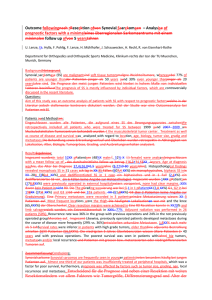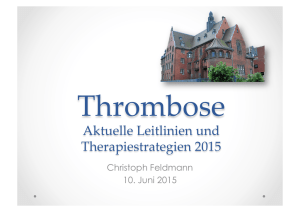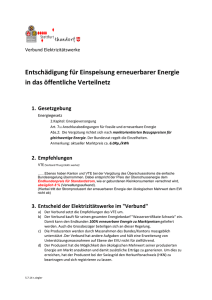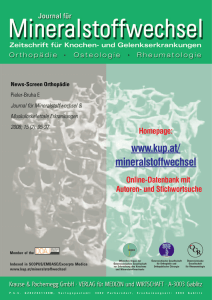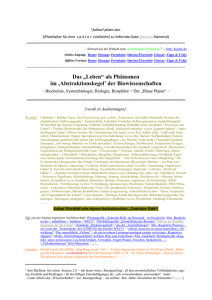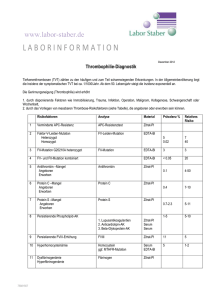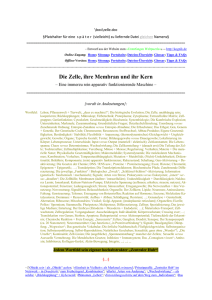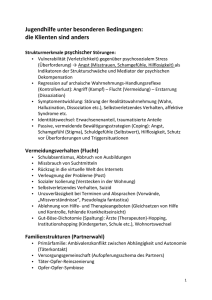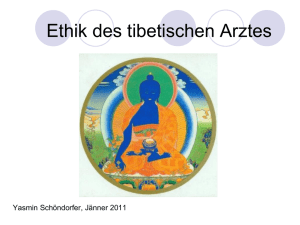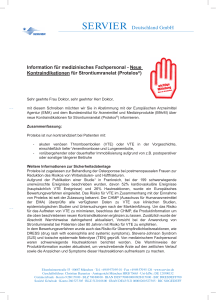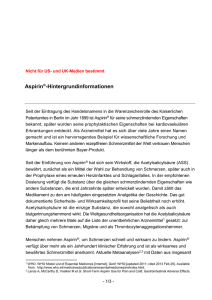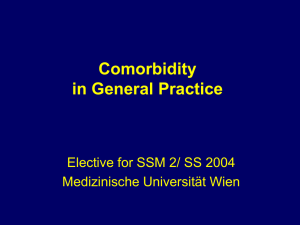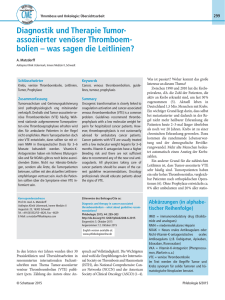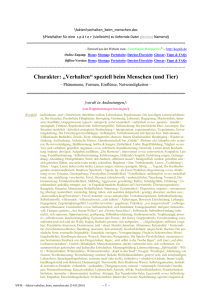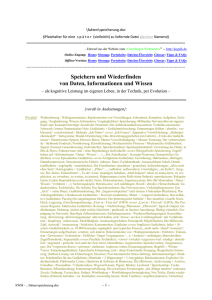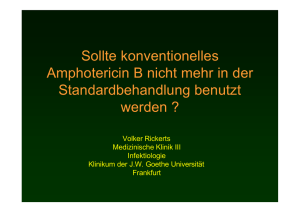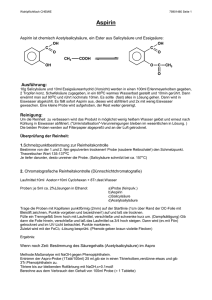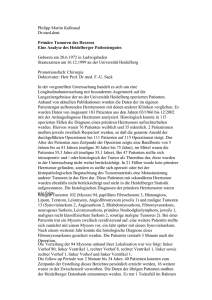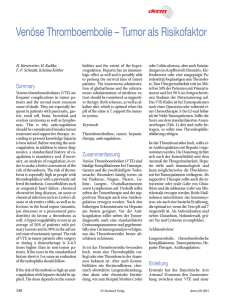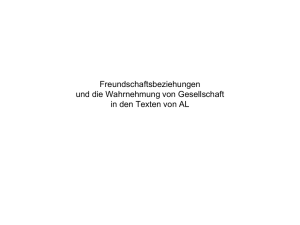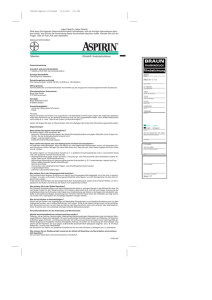Die venöse Thrombose
Werbung
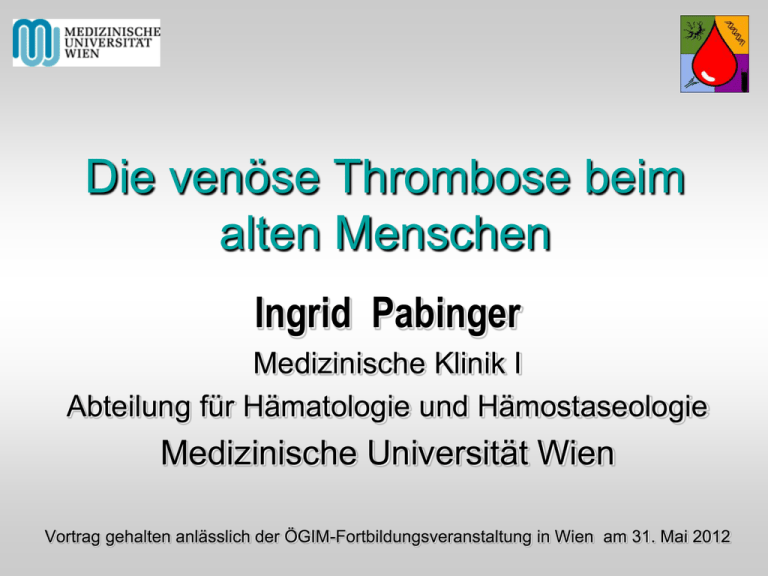
Die venöse Thrombose beim alten Menschen Ingrid Pabinger Medizinische Klinik I Abteilung für Hämatologie und Hämostaseologie Medizinische Universität Wien Vortrag gehalten anlässlich der ÖGIM-Fortbildungsveranstaltung in Wien am 31. Mai 2012 Venöse Thromboembolie beim alten Menschen Epidemiologie Diagnose Akut-Therapie Sekundärprophylaxe Annual incidence of venous thromboembolism among Olmsted County residents, 1966-90, by age and gender Silverstein MD, Arch Intern Med;1998;158:585-93. Venöse Thromboembolien • Inzidenz von VTE (TBVT,PE) bei ambulanten Patienten in Frankreich ca. 1,83/1000 Einwohner • > 75 Jahre : 10/1000 Einwohner Oger E. Thromb Haemost 2000;83:657-60. • Inzidenz von VTE bei stationären Patienten in Worcester: • • • • 40-49 Jährige: 24/1000 Patienten 50-59 Jährige: 43/1000 Patienten 60-69 Jährige: 144/1000 Patienten 70-79 Jährige: 265/1000 Patienten Anderson FA, et al. Chest 2000;118:1680-4. Odds ratio (and 95% confidence interval) of risk factors for definite deep vein thrombosis or pulmonary embolism Heit et al, 2001 Venous thromboembolism in patients nursed at home or in long-term care residential facilities 221 patients, no symptomatic thrombosis, all screened by duplex sonography 18% found to have an asymptomatic DVT Arpaia et al, Int J Vasc Med 2011, doi:10.1155/2011/305027 Adjusted risk factor analysis for VTE in nursed patients * * 1 per 1000 for each month extra in bed Arpaia et al, Int J Vasc Med 2011, doi:10.1155/2011/305027 Diagnose der VTE Age dependent D-dimer in ruling out VTE D-dimer increases with age The negative predictive value remains similar with age adjusted D-dimer Patients > 70 years: 19% higher exclusion rate with age adjusted D-dimer Behandlung der VTE Guidelines des American College of Chest Physicians Kearon et al, Chest Suppl., 2012, 141:419-494 Objektiv diagnostizierte tiefe Venenthrombose Behandlung mit sc. NMH (1xtäglich) oder sc Fondapariux Einleitung der Therapie mit Vitamin K Antagonisten ab erstem Tag Alternativ: Antikoagulation mit neuen oralen Antikoagulantien (Rivaroxaban) Bauersachs et al, NEJM 2010, 363:2499 Bauersachs et al, NEJM 2010, 363:2499 Optimale Dauer der Antikoagulatientherapie Rezidiv versus Blutung Cumulative probability of recurrence in 361 women with a first objectively confirmed VTE before 45 years of age Laszkovicz et al, Haematologica 2007 Clinical risk determinants of recurrence Clinical features allow risk prediction for recurrence Gender (men versus women) Site (PE and proximal versus distal) Unprovoked versus provoked Acute episode effectively versus noneffectively treated Persistent thrombosis versus complete resolution Increased versus normal BMI Cumulative probability of recurrence in patients with normal and abnormal D-dimer Palareti et al, TH 2002 Antikoagulation bei Personen mit hohem DDimer versus Konrollen und Patienten mit niedrigem D-Dimer (Palareti, NEJM 2006) Eichinger et al, Circulation 2010 Rezidivrisiko und Alter Kyrle et al, NEJM 2004, 350: 2558 Risk Factors for Any Fatal Pulmonary Embolism after Discontinuing Anticoagulant Therapy Douketis et al, Ann Int Med, 2007 Dauer der AC-Therapie nach venöser Thromboembolie Transienter Risikofaktor und/oder distale Thrombose Idiopath. Thrombose proximal oder Pulmonalemolie Hohes Blutungsrisiko, schlechte Einstellung, Ablehnung des Patienten Idiopathische rezidivierende Thrombosen 3 Monate langfristig 3 Monate langfristig Aspirin for Preventing the Recurrence of Venous Thromboembolism Introduction: Patients with spontaneous VTE have a Methods: Investigator initiated double-blind Results: Recurrence in 6.3% (27/20%) in Aspirin and recurrence rate of 5-10%/year. Effect of Aspirin is unknown randomized plazebo-controlled trial. 100 mg Aspirin versus placebo 11.0% (42/197) in plazebo patients, one patient in each group had a major bleeding Becattini et al, NEJM 2012, 366:1959 Aspirin for Preventing the Recurrence of Venous Thromboembolism Conclusion: Aspirin reduces recurrence by 40% without increased risk of bleeding Becattini et al, NEJM 2012, 366:1959 Fatal bleeding in patients receiving anticoagulant therapy for venous thromboembolism: RIETE registry Age > 75 years 2.16 1.49–3.16 < 0.001 Recent major bleeding 2.64 1.44–4.83 0.002 Immobility ≥ 4 days 1.99 1.40–2.83 < 0.001 Metastatic cancer 3.80 2.56–5.64 < 0.001 Anemia 1.54 1.07–2.22 0.021 Platelet count < 100 × 109 L−1 2.23 1.16–4.29 0.016 Abnormal prothrombin time 2.09 1.34–3.26 0.001 CrCl levels < 30 mL min−1 2.27 1.49–3.44 < 0.001 Distal DVT 0.39 0.16–0.95 0.038 Nieto et, JTH 2010, 8:1216 Risk Factors Associated With Bleeding during Anticoagulation: Competing-Risk Regression Analysis in 4093 Patients above 80 Years of Age Poli et al, Circulation 2011: 124 824 Die venöse Thrombose beim alten Menschen Ist häufiger als bei jungen Schwieriger zu diagnostizieren (andere Ursachen für Beinschwellung und Schmerz) Diagnose und Antikoagulation wie bei Jüngeren Dauer – 3 Monate und dann….???? Individuelles Vorgehen mit Einschätzung des Blutungsund Rezidivrisikos und der Machbarkeit Alternative Medikamente: Neue orale Antikoagulantien, Aspirin
